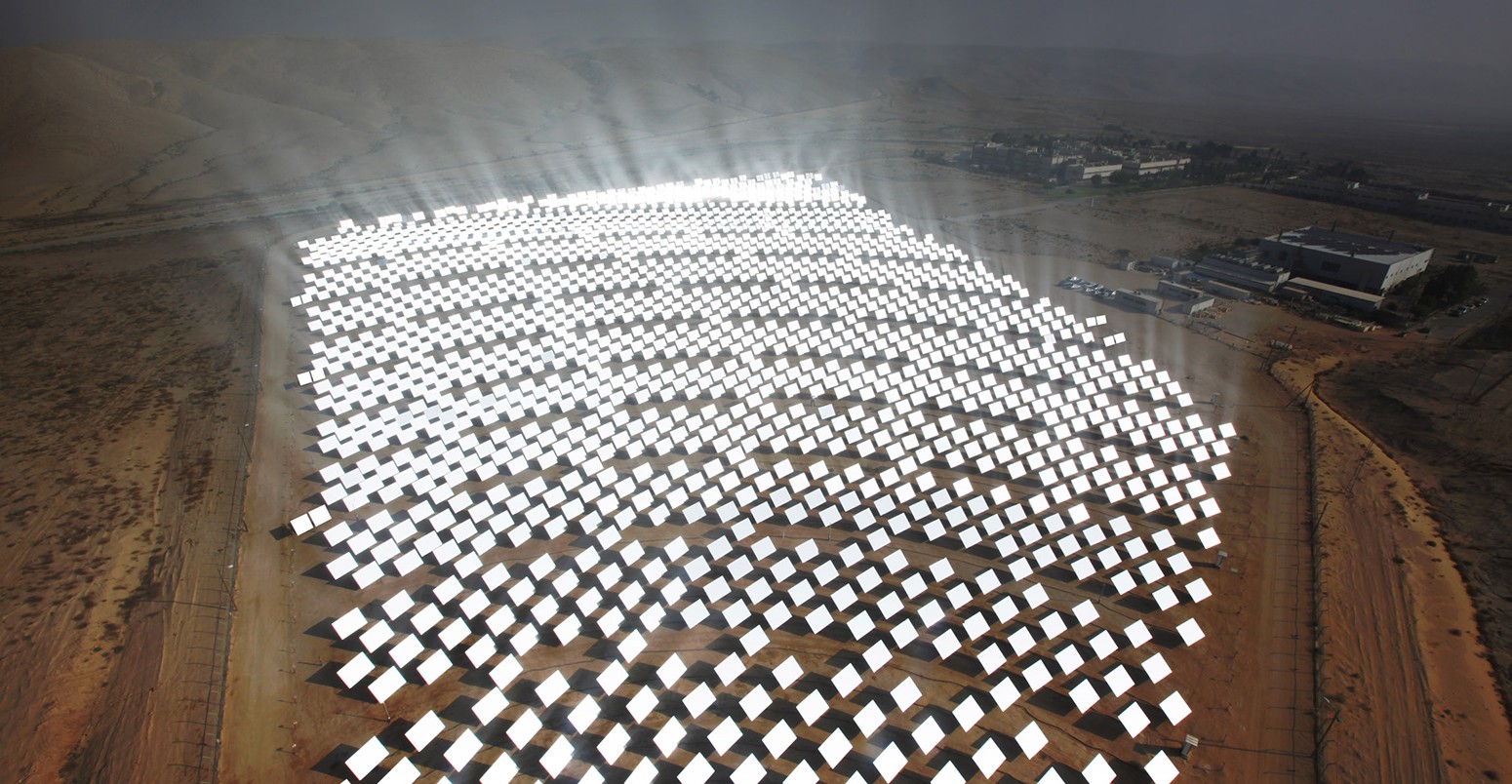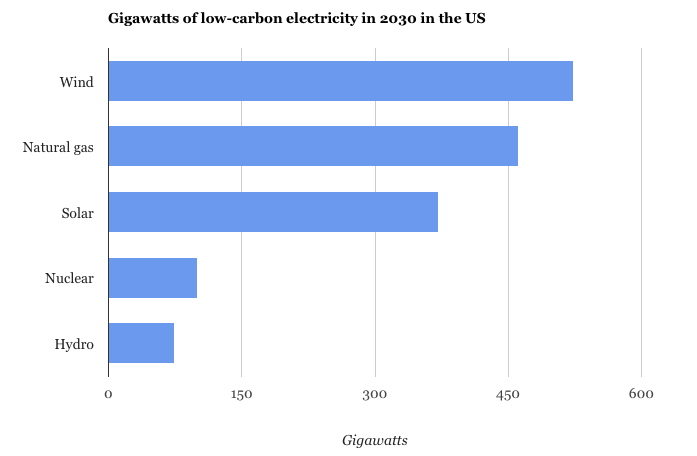
US could cut power emissions 78% by 2030 using existing technology, says study
Sophie Yeo
01.25.16Sophie Yeo
25.01.2016 | 4:00pmIn their pursuit of a connected nation, Americans built transcontinental railroads in the nineteenth century and the interstate highway system in the twentieth century.
With a similar level of effort, the US could construct a nationwide energy infrastructure that cuts carbon dioxide (CO2) emissions by up to 80%, says a study in Nature Climate Change.
This could be achieved without increasing the cost of electricity, thus providing an economic incentive to tackle the problem of climate change.
Previous studies
Scientists have previously tried to model ways to increase the volume of renewables in the electricity sector, so that penetration reaches close to 100%.
But generating power through renewables poses one particular challenge that fossil fuels don’t.
As the weather is variable, solar and wind power stations cannot generate electricity on demand. They can only provide when the sun shines and the wind blows. This is seen as a problem, as the supply and demand for electricity need to be balanced.
Previous studies have tried to get around this by making certain assumptions — for example, the availability of low-cost electrical storage, to control the supply of power. However, energy storage is still a technology in its infancy.
More renewables
A group of academics at the National Oceanic and Atmospheric Administration (NOAA), a US federal agency, has taken a different approach.
They have modelled a future that only uses currently available technologies and excludes electrical storage.
“The model is simply trying to find the least cost combination of generators and transmission to supply power every single hour,” co-lead author Christopher Clack of the Cooperative Institute for Research in Environmental Sciences (CIRES) tells Carbon Brief, adding that the model was “agnostic with respect to technology”.
This requires the construction of a lot more renewable energy power stations.
Building a combination of 1,529GW of solar, wind, natural gas, nuclear and hydro would cover the power needs of the US while reducing CO2 emissions by 78% and keeping costs lower than current projections, the study says.
The additional power stations for requiring this additional capacity would take up 6,570 square-km of US land — around 0.07% of the country’s total area. Several constraints are applied, including not building solar and wind on protected lands.

Generation capacity for a low-cost renewables, high-cost gas scenario where emissions are reduced by 78% on 1990 levels by 2030. Source: Nature Climate Change. Chart by Carbon Brief.
These CO2 reductions are based on a scenario where the US achieves expected cost reductions for renewable energy and increased demand for natural gas, boosting its price. Other scenarios, including a high-cost renewables, low-cost gas scenario similar to 2012, still yielded emissions reductions, albeit less steep.
This is enough to power the whole of the US, even assuming that demand for electricity rises by 14% by 2030. What’s more, the model sees wind and solar substantially increase their share, displacing other fossil fuels and some natural gas, whose share also decreases.
The following two videos show the windiest and sunniest areas of the US, illustrating the US weather system as a whole.
Wind potential
The wind is always blowing somewhere in the United States, though in any given location, it may stall out periodically and there are some locations with better wind resources than others. A new analysis shows that by better matching the scale of the U.S. electricity system to the scale of weather, the country could keep energy costs low, put more wind and solar on the grid, and eliminate much of the sector’s greenhouse gas emissions. The study finds that combining wind and solar is important as they are complementary. This animation covers 10 days in January 2008. Visualization by Chris Clack/CIRES.Solar potential
Solar resources vary across the country, with greater potential in the South (and during the day). A new analysis shows that by better matching the scale of the U.S. electricity system to the scale of weather, the country could keep energy costs low, put more wind and solar on the grid, and eliminate much of the sector’s greenhouse gas emissions. The study finds that combining wind and solar is important as they are complementary. This animation covers 10 days in January 2008. Visualization by Chris Clack/CIRES.Transmitting electricity today
Increasing the number of power stations is not enough to create a reliable source of electricity. The problem of intermittency remains.
To resolve this, the model uses the variability of the weather as a strength, rather than a hindrance, by creating a single electrical power system across the US — a solution which the study says is cheaper than integrating energy storage.
Currently, the US electrical system is split into three areas. These areas are called “interconnections”, each of which operates largely independently, with very little electricity transferred between them.
These three areas are further split into smaller units called Balancing Authorities, which work to maintain the balance of supply and demand in their areas.
A US-wide system
However, the larger the area, the more effective they can be at balancing the supply and demand of electricity. This is particularly true when it comes to integrating intermittent renewables into the grid.
Having a larger area means that there is a larger volume of potential resources.
It takes advantage of the fact that the variability of the weather decreases as geographical area increases — that is to say, if the wind is not blowing in one place, it is likely to be blowing some place else. The model is the first to “incorporate weather data at high resolution over continental scale and yearly time horizons,” Clack points out.
This means that, rather than abandoning households and businesses to the vagaries of the weather in their own area, a large electrical system provides access to a vast pool of places they can send their excess electricity on sunny or windy days, and from which they can import electricity when it is calm or cloudy.
The study connects up the whole of the US through a network of high-voltage direct-current (HVDC) transmission lines, which is capable of transporting electricity over long distances.
The study shows that a larger grid is better than a smaller grid when it comes to integrating renewables. It says:
As the size of the connected system grows, the amount of wind and solar PV generation increases. Moreover, the cost of electricity decreases as the area increases, because the system has access to more remote, rich resources and the correlation between connected sites weakens.
Cost
This system could save Americans $47.2bn every year, says the study. The scenario outlined above would reduce the costs to 10 cents per kWh.
The saving is relative to the predictions of the International Energy Agency (IEA) and the Energy Information Administration (EIA). They estimate that the cost of electricity in the US in 2030 will be 11.5 cents per kilowatt hour (kWh).
Would coal be cheaper? Yes, say the researchers. Including coal in their modelling reduced the cost of electricity to 8.5c/kWh, but CO2 emissions were 37% higher than 1990 levels.
This is incompatible with the US target to reduce emissions 26-28% by 2025 on 2005 levels. And, as the study points out, large numbers of coal plants in the US are already being retired for age, economic or environmental reasons.
Difficulties
The challenges involved in implementing a low-carbon, transcontinental system would be far from negligible, as the study point out. It cites barriers including the current regulatory, commercial and legal system, and the required investment in the new transmission system and power plants.
The paper says that the decarbonisation of the electricity sector is likely to encourage further decarbonisation across the entire energy sector.
Alexander MacDonald, co-lead author on the study and also from NOAA, tells Carbon Brief:
If electric energy is cheap, then other electric users, such as autos and heat pumps are more likely to use it. Right now electric car fuel costs are significantly less expensive than fossil fuel costs.
He adds:
There are industry estimates that the purchase cost and range of electric cars should improve a lot over the next few years, and if they do, then having an inexpensive source of electric energy as is shown in our study, would help decarbonize transportation. Cheap, low carbon electricity would therefore help decarbonize other energy sectors.
With widespread use of electrical storage still distant and coal in decline, the study gives a snapshot of what the US electricity system could look like in a decarbonised future.
MacDonald, A. E. et al. (2016) Future cost-competitive electricity systems and their impact on US CO2 emissions, Nature Climate Change, doi: 10.1038/nclimate2921.
-
US could cut power emissions 78% by 2030 using existing technology, says study

